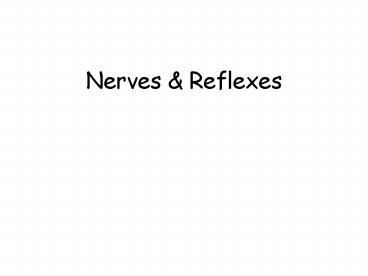Nerves - PowerPoint PPT Presentation
Title:
Nerves
Description:
Nerves & Reflexes Retina receives the image The Retina is at the back of your eye. It is full of light receptors which are sensitive to; Colour & Light levels Can ... – PowerPoint PPT presentation
Number of Views:102
Avg rating:3.0/5.0
Title: Nerves
1
Nerves Reflexes
2
The nervous system enables humans to react to
their surroundings and coordinate their behaviour.
3
Receptors detect stimuli which include light,
sound, changes in position, chemicals, touch,
pressure, pain and temperature.
Where are your receptors?
4
Stimulus Detected by
Pressure Receptors under skin
Pain Receptors under skin
Pleasure Receptors under skin
Temperature Receptors under skin
Light/visual Receptors in the Eye
Sound Receptors in the Ear
Taste Receptors in the Mouth
Smell Receptors in the Nose
5
What are these receptors? How do they work?
6
The Receptors are nerve endings. The nerves make
up your Central Nervous System along with your
spinal chord and brain.
7
Retina receives the image
- The Retina is at the back of your eye.
- It is full of light receptors which are sensitive
to Colour Light levels
Fovea
Optic Nerve
The Fovea is the main focal point and it has the
greatest density of light receptors
8
Information from receptors passes along cells
(neurones) in nerves to the brain. The brain
coordinates the response.
9
- Can you see
- The optic nerve bundle?
- The spinal cord?
10
Nerve Cells
- Nerve cells are highly specialised.
- Their structure is directly linked to their
function
11
This picture was taken using electron microscopy.
It shows the synapses, or connections, between
two nerve fibres (in purple) and a nerve cell
(yellow). The picture is magnified 10,000 times.
12
(No Transcript)
13
How does their structure relate to their function?
- STRUCTURE
- Long axon
- Dendrites on cell body
- Myelin sheath (fatty sheath)
- FUNCTION
- Can reach to far places in the body
- Allows nerve cells to connect with each other to
pass on impulses (messages) - Acts as insulation so the impulses do not cross
over to other cells
14
What do nerve cells do?
- Nerve cells connect to receptors at one end.
- Some nerves carry impulses to the brain.
- From here the brain will decide what response is
necessary. - Once it has decided what to do, the brain will
send another impulse through another nerve cell. - These nerves connect to a muscle or gland at the
other end. - The muscle or gland carries out the job required
15
Stimulus? receptor ? nerve ? brain ? nerve ?
muscle/gland ? response
- As you can see there are 2 nerves involved in
this chain. We can give these nerves special
names according to the jobs they do - We call the first nerve in the chain the SENSORY
NERVE. This is because it is involved in the
sensing of the stimulus. - We call the second nerve the MOTOR NEURONE. This
one is involved in bringing about the response to
the stimulus. - We can also call the muscle/gland the EFFECTOR.
This is easier as it is only one word and can
mean either muscle or gland. It is the part
actually doing something. - So our chain can now look like this
Stimulus? receptor?sensory nerve? brain? motor
neurone? effector?response
16
- Working example
- See your friend ? receptors in eye ? sensory
nerve ? brain ? motor neurone ? arm muscles ?
wave - Try and think of your own example and write it
down
17
Reflex actions
Reflex actions are automatic and rapid. They
often involve sensory, relay and motor
neurones. You need to know the role of
receptors, sensory neurones, motor neurones,
relay neurones, synapses and effectors in simple
reflex actions.
18
Reflexes
- Some responses need to be really, really quick.
We need to be able to do this without thinking. - If we are in danger of harming ourselves we would
need to act without thinking about what to do. - We call this a reflex. It is like an action that
is already programmed into our nervous systems
it happens automatically. - With reflexes the sensory nerves do not travel
all the way to the brain. This would take too
long if we were in danger. - Instead the impulses are taken to the spinal cord
as it is closer. - Look at the next diagram and label your own.
19
Motor Neurone
Effector (muscle)
Relay Neurone
Sensory Neurone
Spinal Cord
Receptor
Stimulus (heat)
20
Activity
- Write down as many reflex actions as you can
think of.. - Write out the chain of events for a reflex like
the chain we went through before. Pick a specific
type of reflex from your list and write out the
chain.
21
Questions
- 1) What do these words mean
- - stimulus
- - response
- - effector
- 2) What is the special name given to the nerve
that carries the impulse from the receptor to the
brain or spinal cord? - 3) What is the special name given to the nerve
that carries the impulse from the brain or spinal
cord to the effector? - 4) What is the name given to the brain and spinal
cord together? - 5) Write the chain of events for the following
scenario - A silly year 11 boy has just thrown a pen
towards a year 7 boys face. What does the year 7
boy do?
22
Link to past paper questions
Link to answers

